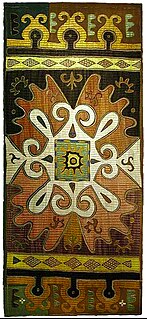
The Northeast Caucasian languages, or Nakh-Daghestanian languages, are a language family spoken in the Russian republics of Dagestan, Chechnya and Ingushetia and in northern Azerbaijan as well as in diaspora populations in Western Europe, Turkey and the Middle East. They are occasionally called North Caspian, as opposed to North Pontic for the Northwest Caucasian languages.
The Dargwa or Dargin people are a Northeast Caucasian native ethnic group originating in the North Caucasus, and who make up the second largest ethnic group in the Russian republic of Dagestan. They speak the Dargwa language. The ethnic group comprises, however, all speakers of the Dargin languages; Dargwa is simply the standard variety.

The Lak language is a Northeast Caucasian language forming its own branch within this family. It is the language of the Lak people from the Russian autonomous republic of Dagestan, where it is one of six standardized languages. It is spoken by about 157,000 people.

The peoples of the Caucasus are diverse comprising more than 50 ethnic groups throughout the Caucasus region.
Baron Peter von Uslar (1 September [O.S. 20 August] 1816 — was a Russian general, engineer and linguist of German descent, known for his research of languages and ethnography of peoples of Caucasus.

Kaitag textiles are an unusual embroidered textile art form from the Kaytagsky District of southeast Dagestan, Russia, inhabited mainly by Dargins and Kumyks. Kaitag textiles are of simple construction, being laid and couched silk-floss embroidery on a cotton ground. The designs are often in the style of classical Safavid Persian art, sometimes illustrating horsemen and hunting scenes. Abstract Kaitag designs have been compared to those of Matisse and Paul Klee, though it is unlikely that either artist ever saw a Kaitag textile. Surviving examples are mostly from the 17th and 18th centuries. These embroideries were apparently made for local use in weddings, funerals, and for cradle trappings. The traditional Kaitag art of embroidery was reportedly stamped out under Soviet rule.

The Dargin languages consist of a dialect continuum of Northeast Caucasian languages spoken in southcentral Dagestan. Kajtak, Kubachi, Itsari, and Chirag are often considered dialects of the same Dargin/Dargwa language. Ethnologue lists these under a common Dargin language, but also states that these may be separate languages from Dargwa proper.
Kajtak (Kaytak) is a language from the Dargin dialect continuum spoken in Dagestan, Russia. It is often considered a divergent dialect of Dargwa. The Ethnologue lists it under the dialects of Dargwa, but recognizes that it may be a separate language.
Kubachi is a language from the Dargin dialect continuum spoken in Dagestan, Russia. It is often considered a divergent dialect of Dargwa. The Ethnologue lists it under the dialects of Dargwa, but recognizes that it may be a separate language.
Itsari is a language from the Dargin dialect continuum spoken in Dagestan, Russia spoken in the village Itsari by about 2,000 people. It is often considered a divergent dialect of Dargwa. The Ethnologue lists it under the dialects of Dargwa, but recognizes that it may be a separate language.
Chirag is a language from the Dargin dialect continuum spoken in Dagestan, Russia. It is often considered a divergent dialect of Dargwa. The Ethnologue lists it under the dialects of Dargwa, but recognizes that it may be a separate language.

Magomedsalam Magomedaliyevich Magomedov is a Russian politician who served as the third President of Dagestan, a federal subject of the Russian Federation found in the North Caucasus region, from 2010 to 2013. His appointment by the President of Russia was approved by the parliament of Dagestan on February 10, 2010. Magomedov is an ethnic Dargin. His father, Magomedali Magomedov, served as President of Dagestan between 1987 and 2006. It is his stated ambition as president to consolidate and modernise the republic to counter the threat of Islamic extremism, in particular the attempts made to undermine and terrorise the republic by supporters of the so-called Caucasus Emirate. His resignation was accepted by President Vladimir Putin on January 28, 2013.
Northcaucasian race is a term
for a proposed sub-race of the larger Caucasian race prosed by Carleton S. Coon (1930).
It comprises the native populations of the North Caucasus, the Balkars, Karachays and Vainakh .
Magomed Vagabov, also known as Emir Seyfullah or Seyfullah Gubdensky, was the leader of the militant Vilayat Dagestan organisation in the Russian Republic of Dagestan, and the Supreme Qadi of the Caucasus Emirate.

The Dagestan Oblast was an oblast (province) of the Caucasus Viceroyalty of the Russian Empire. It roughly corresponded to most of present-day southeastern Dagestan. It was created in 1860 out of the territories of the former Caucasian Imamate.

The Zakatal Okrug was an okrug (district) of the Tiflis Governorate of the Caucasus Viceroyalty of the Russian Empire. It roughly corresponded to most of present-day Balakan, Zaqatala and Qax regions in Azerbaijan. It was created out of the territories of the former Free Jamaats of Jar-Balakan and had a special status of a military administrative unit.
Dargin writing is a written form of communication representing the North East Caucasian Dargin language. This language has approximately 439,000 speakers, most of whom live in the Russian republic of Dagestan. Additionally, Darlin writing is used in the Russian Republics of Kalmykia, Khantia-Mansia, and Chechnya, as well as nearby countries of Azerbaijan, Kazakhstan, Kyrgyzstan,
Turkey, Turkmenistan, Ukraine, and Uzbekistan.







